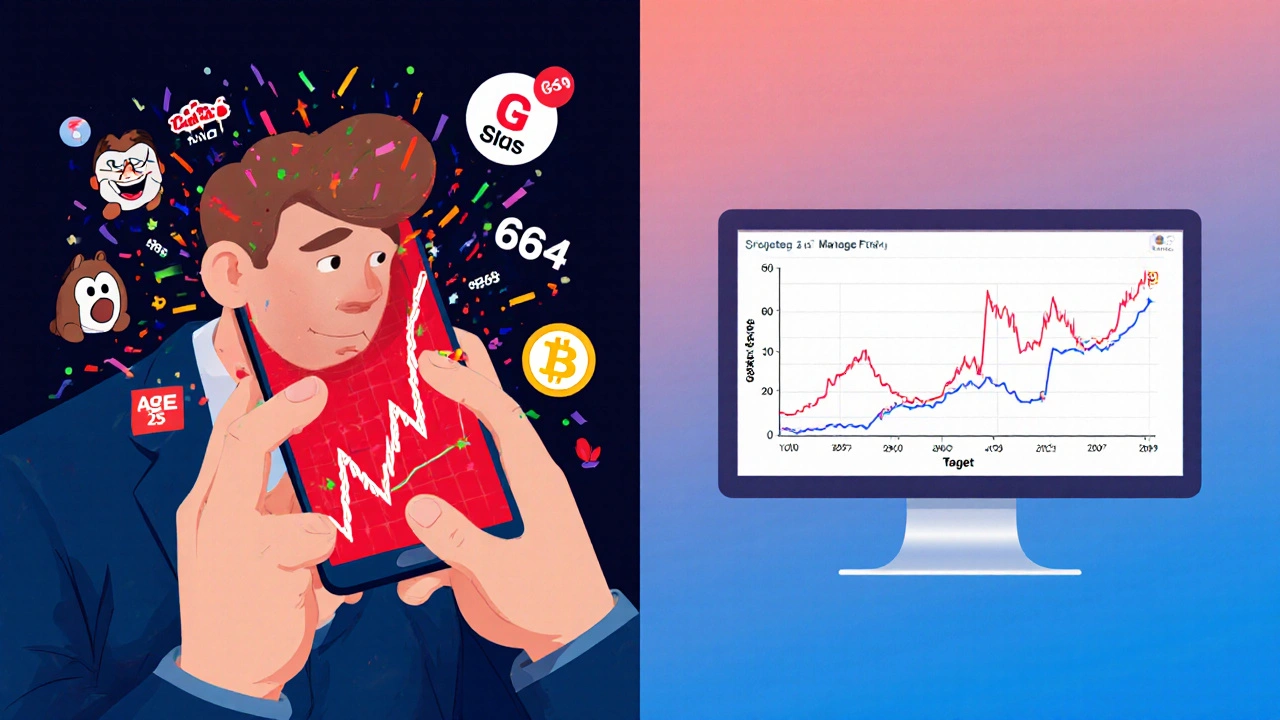Most people think investing is for rich folks with fancy portfolios and financial advisors. That’s a myth. The truth? Anyone can grow wealth-starting with $50, a steady paycheck, and the right habits. The real barrier isn’t money. It’s confusion. Too many guides throw around terms like ETFs, asset allocation, and rebalancing without explaining what they actually do for your bank account. This guide cuts through the noise. It shows you exactly how to build wealth over time, step by step, with real tools and real results-not theory.
Why Most People Never Build Wealth
Let’s be honest: most people don’t fail because they earn too little. They fail because they do the wrong things with what they have. A 2024 Federal Reserve study found that 63% of Americans have less than $1,000 in savings. Meanwhile, the top 10% hold 70% of the nation’s wealth. The gap isn’t about income. It’s about behavior.
People chase hot stocks they read about on TikTok. They panic-sell when the market drops 5%. They keep cash in savings accounts earning 0.5% while inflation eats 3% a year. They wait for the ‘perfect time’ to start investing. That time never comes.
The secret? Wealth isn’t built by timing the market. It’s built by time in the market. And consistency. You don’t need to be smart. You just need to be steady.
How Compound Growth Actually Works
Compound growth is the engine behind every billionaire’s net worth. It’s not magic. It’s math. Here’s how it works:
Let’s say you invest $300 a month starting at age 25. You earn an average of 7% per year-realistic for a broad market index fund. By age 65, you’ll have $742,000. That’s $144,000 you put in. The rest-$598,000-came from growth. That’s 80% from compounding.
Now, if you wait until 35 to start? You’d only have $363,000 by 65. Same monthly amount. Same return. Ten years later, you lost nearly half your wealth. That’s the power of time.
Compound growth doesn’t care how much you start with. It cares how long you let it work. Even $50 a month, started young, can turn into $100,000+ over 40 years.
The Only Three Investments You Need
You don’t need 10 different funds. You don’t need crypto, gold bars, or rental properties to start. You need three things:
- Low-cost index funds - These track the entire stock market. Examples: VTI (Vanguard Total Stock Market ETF), ITOT (iShares Core S&P Total U.S. Stock Market ETF). They cost less than 0.03% per year. That’s $3 on $10,000. Compare that to mutual funds charging 1% or more.
- Target-date funds - These are automatic portfolios that adjust as you get older. Fidelity, Vanguard, and T. Rowe Price offer them. If you’re 30 and plan to retire at 65, pick the 2060 fund. It starts aggressive, then slowly shifts to safer assets as retirement nears. No decisions needed.
- High-yield savings accounts - Not for growth. For emergencies. Keep 3-6 months of living expenses here. Right now, rates are around 4.5%. That’s 10x what most banks pay. Use Ally, Marcus, or Discover.
That’s it. You don’t need to pick individual stocks. You don’t need to time the market. You don’t need to understand options. Just invest in these three, stick with them, and ignore the noise.
How to Start Investing (Step-by-Step)
Here’s how to begin today:
- Open a brokerage account - Use Fidelity, Charles Schwab, or Vanguard. All have $0 fees, no minimums, and mobile apps that make investing simple.
- Set up automatic transfers - Link your checking account. Schedule $50, $100, or whatever you can afford to move in every payday. Automate it. Out of sight, out of mind.
- Buy one target-date fund - Search for the fund matching your retirement year. Click ‘Buy’. Done.
- Wait - Don’t check your balance daily. Don’t react to headlines. Let it grow.
That’s the whole process. No spreadsheets. No research. No stress. Just action.

What Not to Do
Here are the top mistakes that destroy wealth:
- Chasing meme stocks - GameStop, AMC, Dogecoin. These are gambling, not investing. The odds of winning are worse than a slot machine.
- Trying to beat the market - Less than 10% of active fund managers outperform the S&P 500 over 10 years. You’re not smarter than the professionals.
- Selling during crashes - The market drops 10% every year on average. It drops 20% every 3-5 years. If you sell, you lock in losses. If you hold, you recover-and often make more.
- Waiting for ‘more money’ - You’ll never feel ready. Start now with what you have.
- Ignoring fees - A 1% fee on $100,000 is $1,000 a year. Over 30 years, that’s $150,000+ lost to fees. Choose low-cost funds.
How to Handle Market Crashes
Markets crash. That’s normal. In 2020, the S&P 500 dropped 34% in 23 days. In 2022, it fell 19%. In 2008, it lost 50%. Every investor sees this.
What separates winners from losers? What they do next.
When the market crashes, your automatic investments keep going. That means you’re buying shares at lower prices. More shares for the same money. When the market recovers-and it always does-you own more than you did before.
Think of it like buying groceries on sale. Would you stop buying milk because it’s on discount? No. You buy more. Investing works the same way.
Never stop contributing during a crash. That’s when your wealth grows fastest.
When to Add Other Investments
Once you’ve got your core portfolio running for 5+ years and you’re consistently saving, you can consider adding:
- Real estate investment trusts (REITs) - These let you invest in buildings without buying property. Vanguard’s VNQ is a solid option.
- International index funds - The U.S. market isn’t the whole world. VXUS gives you exposure to companies in Europe, Asia, and emerging markets.
- Bonds - As you near retirement, slowly shift 20-40% of your portfolio into bond funds like BND. They’re less volatile and provide steady income.
But don’t rush. Master the basics first. Adding complexity too early just adds risk.

How Much Should You Invest?
There’s no magic number. But here’s a simple rule: aim to save and invest at least 15% of your gross income. If you make $50,000 a year, that’s $7,500. About $625 a month.
If that’s too much right now? Start with 5%. Then increase by 1% every six months. Raise your contribution when you get a raise, bonus, or pay off a debt. Small steps add up.
And don’t forget tax-advantaged accounts:
- 401(k) - If your employer offers one, contribute enough to get the full match. That’s free money.
- IRA - If you don’t have a 401(k), open a Roth IRA. You pay taxes now, but withdrawals in retirement are tax-free.
Max out these accounts before investing in a regular brokerage account.
What Wealth Looks Like After 10, 20, 30 Years
Let’s say you invest $500 a month at 7% annual return:
- After 10 years: $87,000
- After 20 years: $255,000
- After 30 years: $610,000
That’s not fantasy. That’s math. And it’s repeatable. You don’t need to be rich. You just need to start.
Final Thought: Wealth Is a Habit, Not a Windfall
You won’t get rich overnight. But you can get rich slowly. And that’s how most people who actually become wealthy do it.
Stop waiting. Stop overcomplicating. Start small. Stay consistent. Let time do the heavy lifting.
The best time to start investing was 10 years ago. The second best time? Today.
Can I start investing with $100?
Yes. Many brokers like Fidelity, Schwab, and Robinhood let you buy fractional shares. That means you can invest $100 in an ETF like VTI and own a piece of Apple, Microsoft, and Amazon-all in one trade. You don’t need thousands to begin.
Is investing safe?
Investing carries risk, but so does not investing. Keeping money in cash loses value to inflation over time. Index funds spread your risk across hundreds or thousands of companies. Historically, the S&P 500 has returned about 7% annually after inflation over the last 90 years. Long-term investing reduces risk through time.
Should I invest in crypto?
Crypto is speculative, not an investment. It doesn’t generate income, has no earnings, and its value is based entirely on what others are willing to pay. If you want to speculate, limit it to 1-5% of your portfolio-after you’ve built your core investments in index funds.
How often should I check my investments?
Once a quarter is enough. Checking daily or weekly leads to stress and bad decisions. The market moves every second, but your strategy shouldn’t. Focus on your long-term goals, not daily price swings.
What’s the difference between a Roth IRA and a 401(k)?
A 401(k) is offered through your employer. Contributions are made before taxes, lowering your taxable income now. You pay taxes when you withdraw in retirement. A Roth IRA is opened individually. You pay taxes now, but withdrawals in retirement are tax-free. Both are great-use both if you can.
Do I need a financial advisor?
Not to start. If you’re investing in low-cost index funds and keeping things simple, you don’t need one. Advisors charge 1% of your assets annually. That can cost you hundreds of thousands over time. Only consider one if your situation is complex-like owning a business, inheriting assets, or planning for estate taxes.
Next steps: Open a brokerage account today. Set up one automatic transfer. Pick a target-date fund. Then walk away. Your future self will thank you.


